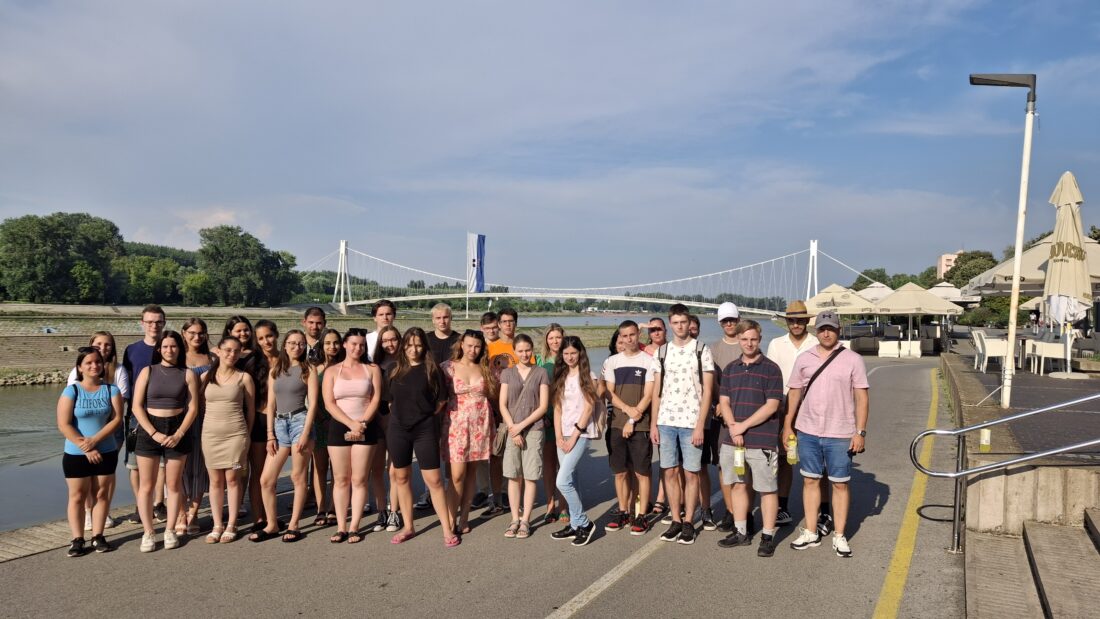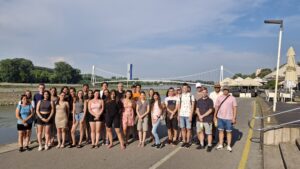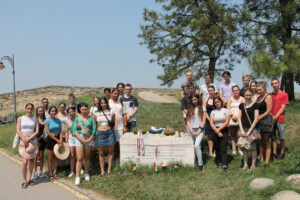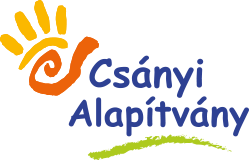
HISTORICAL CAMP IN CROATIA AND SERBIA
On 14th July 2024, the Mohács 3, Nagybajom 1 and Pécs 2 groups started this year’s camp in a wonderful place, Osijek on the banks of the Drava, which is the perfect location to explore new places and learn about the history of the South Slavic War and the history of the Hungarian people in the South. Today we were joined by our guide, István Koteczki, who gave us a brief introduction to the city’s most important sites, and then we had ice cream and a walk along the banks of the Drava for a chat. On the following days, we will visit the meadow of Kopácsi, the centre of Osijek and Vukovar, where the bloodiest siege of the war took place. And in the second half of the week we will visit the Hungarian monuments of Serbia and lay a wreath at the castle of Nándorfehérvár.
NB1, M3, P2 groups
In mid-July, we travelled to Croatia and Serbia for a history and heritage camp. We started the week in Croatia and then travelled to Serbia. In Croatia, we stayed at the Hotel Osijek in Osijek. The day after our arrival, we went for a boat trip in the meadow of Kopács, where we were given a local tourist guide who told us about the most characteristic creatures that surrounded us during the boat trip, such as cormorants and grey herons. This allowed us to learn more interesting facts about the different species. In the nature we had a hiking tour in a cheerful atmosphere. In the late afternoon we went for a walk around the city, visiting the castle in Osijek. After that, our city walk didn’t end there, we walked to the Trinity Square near the castle, where we could see the Trinity Column. The next day, we travelled to Vukovar, where we went up to the water tower and had a beautiful view of the Drava River. In two afternoons we could relax on the beach on the banks of the Drava, where we had the opportunity to swim and everyone had a good time despite the heat. On Wednesday, we set off for Serbia, stopping en route at the last Croatian village, where we visited the Catholic Church of St John Capistran in Újlak. When we arrived in Serbia, we stopped in one of the villages to taste Serbian ice cream. After a rest, we continued our journey to Belgrade. Here we stayed at the Holiday Inn hotel, and after everyone had dinner we could go to the Danube bank if we wanted to. On Thursday, we took a full day sightseeing tour of Belgrade with a local guide. Our first stop was the Church of St. Sava, which is an orthodox domed church. We visited the Cathedral, the Castle of Nándorfehervár, where we commemorated the fallen, laid a wreath and then sang the anthem together. We also had the opportunity to see the statue of the Victorious, which we could see from the top of the castle. On Friday, we went to visit the Galamboc Castle, where we first watched a short film about the interesting history of the castle. After we finished at the castle, we stopped at a restaurant in Galamboc where we sampled the local dishes, cevap and pleskavica. It was a meaningful, well-organized week, with many beautiful places to visit and several monuments to see. In my opinion, each day was an eventful day full of sights. In addition to having a good time, we were able to learn more about a fragment of our history thanks to our camp leader and guides.
Zsóka Marián, Nagybajom Group 1
This year’s camp began with a visit to the city of Osijek. We spent three days there before traveling to Belgrade. The aim of the camp was to explore historical Hungary, specifically the regions of Vojvodina, Slavonia, and Southern Hungary.
Our first stop was the Kopacki Rit nature reserve near Osijek, where we were introduced to the area’s wildlife during a brief boat tour. Due to the heat, we took an afternoon swim in the Drava River and later participated in a short city tour in the evening. The next morning, we spent time in Vukovar, where we explored the memorial park dedicated to the Yugoslav War, visited a former water tower, and concluded our visit with a wreath-laying ceremony at the cemetery to honor those who fell in the war.
On the fourth day, we left Osijek and headed towards Belgrade. We made a detour to Novi Sad, where we visited the memorial sites of Saint John of Capistrano and John Hunyadi. On Thursday, we explored the Belgrade Fortress, also known as the Nándorfehérvár Fortress, and enjoyed a well-deserved free afternoon.
On Friday, we visited Galamboč, near the Romanian border, where the reconstructed ruins were particularly interesting, offering insight into the architectural beauty of that era. In the evening, we concluded the camp and set off the next morning for our long journey home.
Flibert Virág, Balla Andrea, Pécs 2 Group
We participated in another fascinating thematic camp, this time exploring Southern Hungary, Slavonia, Vojvodina, and the Danube region within the framework of a Historical and Local Knowledge camp. We took part in numerous activities that enriched our knowledge, providing a detailed understanding of the life and history of the respective countries, cities, and regions.
One of the highlights for me was the local nature conservation park, where we closely observed the local wildlife during a short boat ride. We also visited a tank park, where it was intriguing to see tanks and other military vehicles used in battles and wars; not only could we observe them, but we even had the chance to sit inside.
In the evenings, we enjoyed city walks, more of a sightseeing experience than an educational excursion, focusing on spending time together and enjoying the three days. On Wednesday morning, we continued our journey to Serbia, where we again spent three days. The accommodation was impeccable, and after quickly settling in, we went out for dinner and an evening walk. By the time we reached the waterfront, it was already dark, and the city’s nighttime beauty was simply mesmerizing. I thoroughly enjoyed the experience and learned a lot about Croatia and Serbia. The beautiful cities and stunning nature of these places make me want to return.
Orosz Gergő, Mohács 3




